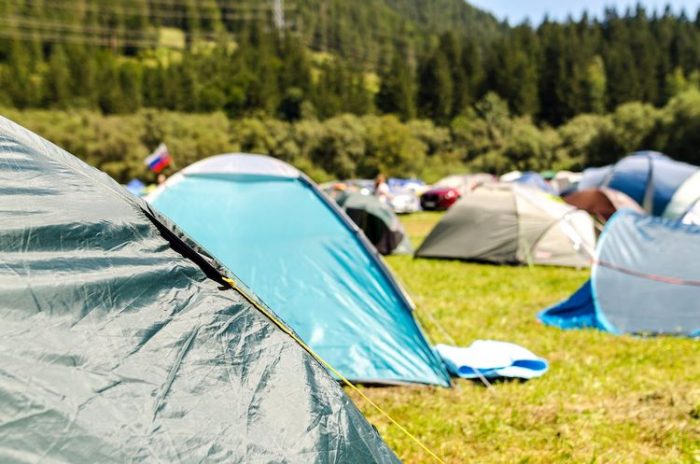This summer is simmering and turns tents into ovens. Unfortunately for me, I’m not a tough cookie for the heat, and would rather not spend my time in an oven tent. Many campsites in the warmer areas provide access to electricity, but that’s not always a possibility. To stay cool while camping in the summer, knowing how to cool a tent without electricity can be a lifesaver. Okay, a trip saver, but it’s a big deal nevertheless.
8 Tips For Hot Weather Tent Camping
Summer is an awesome time for camping, and I wouldn’t miss it. So here are some tips and hacks that make hot weather camping bearable and fun.
1. The Tent Material
Polyester and nylon are popular materials. They’re lightweight, cost-effective, and suck at keeping a tent cool. Canvas, on the other hand, is expensive, heavy, and awesome at maintaining the temperature inside a tent. I’d take a nice canvas tent, and enjoy the benefits it offers.
Keep in mind, canvas tents are heavy. They’re best suited for car camping, or as truck bed tents.
2. Tent Shape
Those cozy little dome tents run the risk of becoming crazy hot in warm weather. I’ll suggest picking a cabin tent for your family vacation. The larger headspace is more comfortable, plus there is more room for air to move. Better airflow will make the tent feel cooler.
Some tents, like Bell Tents, allow the tent walls to be folded up. It’s pretty awesome for airflow, and changing the tent to canopy creates a nice social area as well.
3. Tent Setup And Location
Staying away from the sun reduces heat. It’s better to pitch your tent in a shaded area where direct sunlight won’t heat things up. This may not be always possible, especially if you are at a festival (think Burning Man). Another idea is to place the tent in line with wind direction. If you pitch the tent facing a breeze, the tent will stay well-ventilated, and thus better cooled. Of course, not every campsite will have a consistent breeze, but it’s a good idea to keep wind direction possibility in mind.
4. Care When Setting Up A Tent
At the very least, your tent should sit on a tarp or a footprint. The small insulation this affords can keep your tent cooler. Another idea is to dig a pit, about 2-feet deep, and place your tent in it. This will put the tent closer to the cooler ground, and help reduce temperatures considerably. As awesome as it sounds, to be honest, I don’t fancy myself digging a pit that deep and wide in the sweltering heat. So, a tent footprint it is!
5. Remove The Rainfly
Many tents have a rainfly attached to their body, often covering the mesh roof. Remove the rainfly and you’ll have better ventilation for your tent. Usually, this method works better for cabin tents, since many dome-style tents practically become transparent without their rainfly. If privacy during the day is an important concern, you might just have to bear the heat.
Alternatively, rather than completely removing the rainfly, you can hang it over the tent. Use nearby trees or other objects to tie up the rainfly over your tent. This keeps the tent well-shaded without obstructing ventilation.
6. Use Survival Blankets/Emergency Blankets
Cover your tent with reflective emergency/survival blankets. The shiny side of these blankets should be towards the sun, creating a reflective tent cover. This makes it possible for these blankets to reflect the heat away from the tent. It’s a pretty useful trick for insulation. Alternatively, you can use a shiny rainfly hanging over your tent for a similar effect.
7. Knock Down The Tent During The Day
Do you need to be inside the tent during the day? Chances are, most of the day will be spent on activities outside the tent. Knockdown the tent in the morning, so it does not trap hot air. The tent stays out of the sun during the day, and setting it up during the cooler evening will make it much more comfortable.
This is also applicable when you reach a campsite. Avoid setting up the tent until it is evening. It is troublesome, but sleeping cooler at night is better!
8. Use Battery Powered Fans And Passive Cooling
Carry along some batteries to power one (or a few) battery-powered fans. Having some airflow will make the heat more bearable. For extra cooling, place some ice in a trough and put the fan behind it. The ice-cool air will feel refreshing. If you do use ice, make sure the trough can handle the water as the ice melts. Or empty the vessel/trough periodically.
Staying Cool In A Tent Without Electricity
These quick hacks should be useful for hot weather camping. Not all campsites have an electric supply, and knowing how to cool a tent without electricity can work wonders for comfort.

